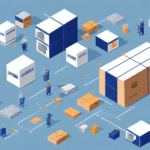Introduction
In the highly competitive world of e-commerce, efficient order fulfillment is essential for business success. Two leading third-party logistics (3PL) providers that help businesses manage warehousing and shipping are Flowspace and Fulfillment by Amazon (FBA). Each service offers distinct advantages and potential drawbacks, making them suitable for different types of businesses. This article provides an in-depth comparison between Flowspace and FBA to help you determine which service best aligns with your e-commerce needs.
Overview of Flowspace and Fulfillment by Amazon (FBA)
E-commerce businesses often encounter challenges such as limited storage space, high shipping costs, and complex logistics. Third-party logistics (3PL) services like Flowspace and FBA offer comprehensive solutions to these issues. According to Investopedia, 3PL providers manage aspects of the supply chain, including warehousing, transportation, and order fulfillment, allowing businesses to focus on their core activities.
What is Flowspace?
Flowspace is a 3PL provider offering businesses access to a nationwide network of warehouses across the United States and Canada. With over 900 fulfillment centers (as of 2023), Flowspace enables businesses to store their products closer to their customer base, thereby reducing shipping times and costs. Their platform provides tools for inventory management, order processing, and shipment coordination, making it a versatile choice for businesses of varying sizes.
What is Fulfillment by Amazon (FBA)?
Fulfillment by Amazon (FBA) is Amazon's proprietary 3PL service that allows businesses to store their products in Amazon's extensive network of fulfillment centers. Leveraging FBA grants businesses access to Amazon's sophisticated distribution infrastructure, ensuring fast shipping and reliable customer service. Furthermore, FBA integrates seamlessly with Amazon's marketplace, providing an efficient pathway to reach millions of potential customers globally.
Pros and Cons
Flowspace Pros
- Extensive Warehouse Network: Over 900 locations across the US and Canada, facilitating proximity to various customer demographics.
- Scalable Solutions: Flexible warehousing options that can accommodate businesses from startups to large enterprises.
- Competitive Pricing: Offers diverse pricing models including pay-as-you-go, volume discounts, and customized pricing based on business requirements.
- User-Friendly Platform: Intuitive interface for managing inventory, processing orders, and tracking shipments.
- Value-Added Services: Additional services such as kitting, labeling, and quality control to streamline the supply chain.
Flowspace Cons
- Geographic Limitations: Services are limited to the United States and Canada, lacking global reach.
- Integration Efforts: May require additional effort to integrate with existing e-commerce platforms and systems.
- Customer Support: Limited support options compared to larger providers like Amazon, with typical response times of 24-36 hours.
- Cost for Low-Volume Businesses: May not be the most cost-effective solution for businesses with low order volumes.
FBA Pros
- Global Reach: Extensive international network of fulfillment centers enabling global shipping capabilities.
- Access to Amazon’s Customer Base: Exposure to millions of active Amazon shoppers, enhancing sales opportunities.
- Advanced Technology: Robust integration with various e-commerce platforms and comprehensive analytics for inventory and sales performance.
- Dedicated Customer Support: 24/7 customer support and dedicated account managers to assist with fulfillment issues.
- Multi-Channel Fulfillment: Ability to fulfill orders from multiple sales channels, including personal websites and other marketplaces.
FBA Cons
- Higher Costs: Fees for storage, fulfillment, and additional services can be substantial, potentially impacting profit margins.
- Inventory Management Challenges: Managing inventory levels within Amazon’s system can be complex, especially during high-demand periods.
- Strict Policies: Rigid requirements for product labeling and packaging can lead to additional costs and delays if not met.
- Limited Brand Control: Reduced ability to customize packaging and maintain brand identity, as products are packaged by Amazon.
- Automatic Refunds: Amazon’s refund policies may result in unexpected losses due to returned items.
Pricing and Customer Support
Flowspace Pricing
Flowspace offers several flexible pricing options to cater to different business needs:
- Pay-As-You-Go: Businesses pay only for the storage space and services they use, providing cost flexibility.
- Volume Discounts: Reduced rates are available for businesses with higher order volumes, encouraging scalability.
- Negotiated Pricing: Customized pricing solutions are available for businesses with specific or large-scale requirements.
Fulfillment by Amazon (FBA) Pricing
FBA's pricing structure includes several fee categories that businesses must account for:
- Storage Fees: Monthly fees based on the volume (cubic feet) that inventory occupies in Amazon's warehouses.
- Fulfillment Fees: Fees per unit which cover the picking, packing, and shipping of products to customers.
- Additional Service Fees: Extra charges may apply for services such as labeling, preparation, or removal of inventory.
Businesses must carefully evaluate these fees against their operational budgets to assess the financial viability of using FBA.
Customer Support
Flowspace offers customer support primarily through email and phone, with typical response times ranging from 24 to 36 hours. While this level of support is suitable for many businesses, it may not match the immediacy of support provided by larger providers.
Fulfillment by Amazon (FBA), in contrast, provides extensive customer support, including 24/7 assistance via phone, email, and chat. Additionally, businesses have access to dedicated account managers who help optimize fulfillment strategies and troubleshoot issues promptly.
Storage and Shipping Facilities
Flowspace excels in offering businesses a wide array of storage solutions spread across the United States and Canada. This extensive network enables businesses to select warehouse locations strategically, enhancing shipping speed and reducing transportation costs.
Fulfillment by Amazon (FBA) leverages Amazon's global infrastructure, with fulfillment centers located in key international markets. This allows businesses to offer expedited shipping options and cater to a global customer base effectively. Amazon continuously invests in its logistics network, ensuring state-of-the-art facilities and efficient order processing capabilities.
Ideal Business Types
Flowspace is Ideal for:
- Small to Medium-Sized Businesses: Looking for scalable and flexible warehousing solutions.
- Multi-Channel Sellers: Businesses selling across various platforms beyond Amazon, such as personal websites or other marketplaces.
- Specialized Products: Companies offering niche products that may require customized fulfillment services like kitting or specialized packaging.
Fulfillment by Amazon (FBA) is Ideal for:
- Large-Scale Operations: Businesses handling high volumes of orders and requiring extensive fulfillment capacity.
- Sellers on Amazon Marketplace: E-commerce businesses that predominantly sell through Amazon and want to leverage its platform for increased visibility and sales.
- Global Businesses: Companies aiming to expand internationally and benefit from Amazon's worldwide fulfillment network.
Expert Insights and Case Studies
Industry experts emphasize the importance of aligning 3PL services with business goals and operational needs. According to a Forbes article, businesses must consider factors like scalability, cost efficiency, and the specific features offered by 3PL providers when making their selection.
Real-life case studies offer practical examples of how Flowspace and FBA have benefited businesses:
- Flowspace: A small artisanal jewelry maker utilized Flowspace’s multiple warehouse locations to enhance delivery speed to customers across North America, resulting in a 25% increase in customer satisfaction and a 20% boost in repeat purchases.
- FBA: A mid-sized electronics retailer expanded its market by leveraging FBA's global network, achieving a 40% growth in international sales within the first year of adoption.
Conclusion: Choosing the Right 3PL Service for Your Business
Choosing the appropriate third-party logistics provider is a critical decision for any e-commerce business. Flowspace offers flexibility, scalability, and cost-effective solutions that are well-suited for growing businesses with diverse sales channels and specialized fulfillment needs. On the other hand, Fulfillment by Amazon (FBA) provides comprehensive support, a vast global network, and seamless integration with Amazon’s marketplace, making it ideal for businesses aiming for large-scale operations and international expansion.
Ultimately, the best choice depends on your business’s specific requirements, budget constraints, and long-term objectives. Conducting a thorough analysis of your operational needs and evaluating the strengths and weaknesses of each 3PL service can guide you toward the optimal solution that supports your business growth and enhances customer satisfaction.
Comparison Table: Flowspace vs Fulfillment by Amazon (FBA)
| Feature | Flowspace | Fulfillment by Amazon (FBA) |
|---|---|---|
| Warehouse Network | Over 900 locations in the US and Canada | Extensive global network |
| Pricing Models | Pay-as-you-go, volume discounts, negotiated pricing | Fixed storage and fulfillment fees |
| User Interface | Intuitive and user-friendly platform | Advanced tracking and analytics |
| Customer Support | Email and phone support with 24-36 hour response time | 24/7 support with dedicated account managers |
| Value-Added Services | Kitting, labeling, quality control | Packaging, multi-channel fulfillment |
| Ideal For | Small to medium businesses, multi-channel sellers | Larger businesses, Amazon marketplace sellers |




















